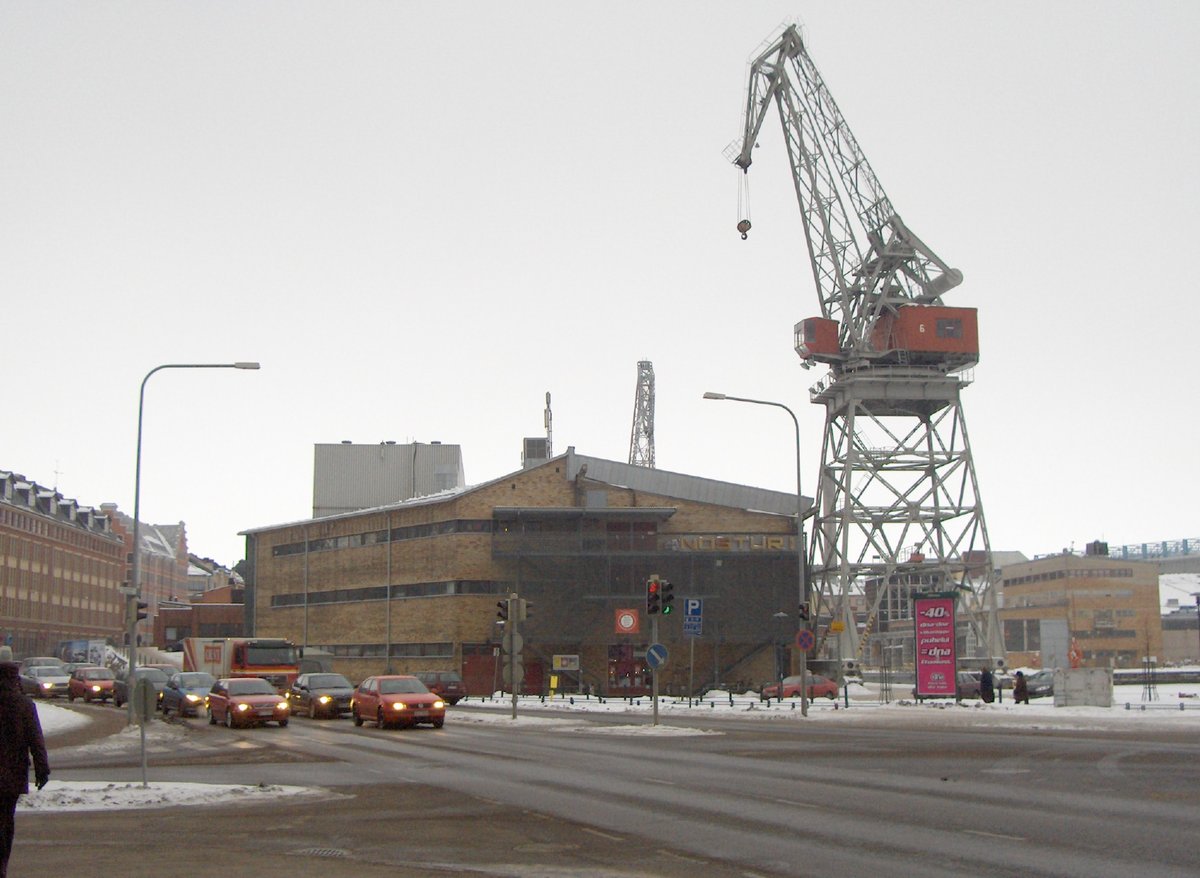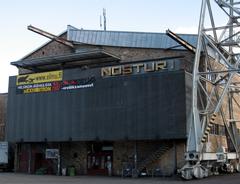
Nosturi Helsinki: Visiting Hours, Tickets, and Historical Significance Guide
Date: 15/06/2025
Introduction: Nosturi’s Place in Helsinki’s Cultural Landscape
Nosturi Helsinki was a cornerstone of Finland’s live music and cultural scene, located in the Punavuori district along the historic Hietalahti shipyard waterfront. Established by the cultural association ELMU in 1999, Nosturi—meaning “The Crane”—inhabited a repurposed industrial warehouse built in 1957. Its unique setting showcased Helsinki’s maritime and industrial heritage, serving as a symbol of urban transformation and creative reuse (Songkick, Live the World).
Over two decades, Nosturi became much more than a concert venue. It nurtured alternative and underground music, hosted over 800 concerts across genres like rock, metal, electronic, and indie, and was pivotal in launching the careers of iconic Finnish bands such as HIM, Nightwish, and The Rasmus. Managed on a non-profit basis by ELMU, Nosturi fostered grassroots participation, workshops, exhibitions, and youth programs, making it integral to Helsinki’s creative fabric (Helsinki Times, Nightflow).
Despite its cultural importance, Nosturi closed permanently in late 2019 due to urban redevelopment, and the building was demolished in early 2020. The closure ignited debates about balancing heritage with urban growth. Nosturi’s legacy, however, endures in Helsinki’s ongoing music innovation and in the advocacy for new cultural spaces (Gramex, Wikipedia).
This guide explores Nosturi’s evolution, cultural impact, and the present-day live music scene in Helsinki, including practical visitor tips, alternative venues, and ways to experience the city’s musical heritage.
Table of Contents
- Introduction: Nosturi’s Place in Helsinki’s Cultural Landscape
- Origins and Architectural Context
- Cultural Significance and Community Role
- Notable Events and Performances
- Closure and Urban Development
- Nosturi’s Legacy and Impact
- Practical Visitor Information: Alternatives & Area Attractions
- Frequently Asked Questions (FAQ)
- Conclusion: Nosturi’s Enduring Influence
- References
Origins and Architectural Context
Founded in 1999 by ELMU (Elävän musiikin yhdistys – Live Music Association), Nosturi succeeded the influential Lepakko venue. The building itself, a former 1957 cargo warehouse at Telakkakatu 8, was emblematic of Helsinki’s adaptive reuse trends. Its utilitarian architecture—with exposed steel beams and panoramic waterfront views—celebrated the city’s industrial and maritime past, as it transitioned from shipyards to creative urban districts (Songkick, Live the World).
Cultural Significance and Community Role
Nosturi operated as a non-profit cultural hub, championing inclusivity and supporting Helsinki’s alternative and underground music scenes. Besides concerts, it hosted workshops, art exhibitions, and youth programs, providing rehearsal spaces and fostering a sense of community. Managed by ELMU, it was a platform for both emerging and established local talent as well as international acts (Songkick, Nightflow).
Notable Events and Performances
Nosturi’s diverse programming included over 800 concerts, featuring Finnish legends like HIM, Nightwish, Children of Bodom, and The Rasmus, as well as international artists such as Motörhead, Anthrax, and The Hives. Its flexible layout—main hall capacity around 900, with a smaller upstairs club—accommodated both intimate shows and large-scale festivals. Annual themed events and New Year’s Eve parties were staples of Helsinki’s nightlife (Songkick).
Closure and Urban Development
The transformation of Helsinki’s docklands into residential and commercial districts marked the end for Nosturi. The city’s redevelopment plans for Telakkaranta led to the non-renewal of Nosturi’s lease, and the venue held its final concert in December 2019. Demolition began in early 2020, sparking public debate about the future of cultural spaces in urban development (Helsinki Times, Wikipedia, fi.wikipedia).
Nosturi’s Legacy and Impact
Although Nosturi no longer stands, its legacy is deeply etched into Helsinki’s cultural identity. It remains a symbol of musical innovation, inclusivity, and community spirit. ELMU continues its advocacy, seeking new venues—such as the historic Verkatehdas building in Vanhankaupunginkoski—to revive the spirit of Nosturi. The story of Nosturi has influenced city planning discussions, emphasizing the need to balance urban development with the preservation of grassroots cultural spaces (Gramex).
Practical Visitor Information: Alternatives & Area Attractions
Can I Visit Nosturi?
Nosturi is permanently closed and demolished; there are no visiting hours or ticket sales.
Where to Experience Live Music in Helsinki Now
Helsinki’s music scene remains vibrant, with several venues continuing Nosturi’s legacy:
- Tavastia Club: Historic rock venue in the city center (Tavastia).
- Kulttuuritalo (House of Culture): Renovated and hosting a diverse calendar of events.
- Böle Arena & Club: Large concerts and festivals, easily accessible via public transport.
- Ääniwalli: Industrial-style club with frequent live shows.
- Suvilahti: Cultural complex with clubs and outdoor events.
- On the Rocks: Central, intimate venue known for a broad music program.
Check each venue’s official website for schedules, ticketing, and accessibility details (Concerts50).
Exploring the Telakkaranta Area
While Nosturi is gone, Telakkaranta offers scenic waterfront walks, public art, and proximity to the Hietalahti market and the Design District. Guided walking tours and music-themed city experiences often reference the former site of Nosturi.
Accessibility and Getting Around
The Punavuori and Telakkaranta districts are well-served by trams, buses, and pedestrian routes. Most venues and attractions are wheelchair accessible—verify details on each venue’s website or the City of Helsinki tourism pages.
Frequently Asked Questions (FAQ)
Q: Can I visit or attend events at Nosturi?
A: No, Nosturi closed in 2019 and was demolished in 2020.
Q: Which Helsinki venues are recommended for live music now?
A: Tavastia, Kulttuuritalo, Böle Arena, Ääniwalli, and Suvilahti are all excellent choices.
Q: How do I reach Telakkaranta?
A: Take tram lines 6 or 7, or use local buses from the city center. Walking tours also cover the area.
Q: Is ELMU still active?
A: Yes, ELMU continues to support Helsinki’s live music and is working to open new cultural venues.
Q: Can I learn more about Nosturi’s history?
A: Local museums, cultural tours, and ELMU events sometimes feature retrospectives on Nosturi.
Conclusion: Nosturi’s Enduring Influence
Nosturi’s story epitomizes Helsinki’s tradition of cultural vibrancy, community spirit, and creative adaptation. Though the venue is gone, its legacy lives on in the city’s thriving live music scene, innovative venues, and ongoing debates about the value of cultural spaces. For visitors, Helsinki offers a wealth of live music experiences and cultural attractions that reflect both the memory of Nosturi and the city’s forward-looking energy.
Stay updated on Helsinki’s music scene with tools like the Audiala app, follow local venues online, and immerse yourself in the city’s dynamic cultural life. Nosturi’s legacy is a reminder of the enduring power of music and community in shaping urban identity.
References
- Songkick: Nosturi Helsinki
- Live the World: Nosturi Helsinki
- Nightflow: Helsinki Nightlife
- Gramex: New and Renovated Venues in Helsinki
- Wikipedia: Nosturi
- Helsinki Times
- MyHelsinki
- Concerts50: Helsinki Live Music Venues
- Rolling Stone: Live Music in 2025
For further exploration, consider using the Audiala app for curated music venue guides and live event updates in Helsinki.




























































































































































































































